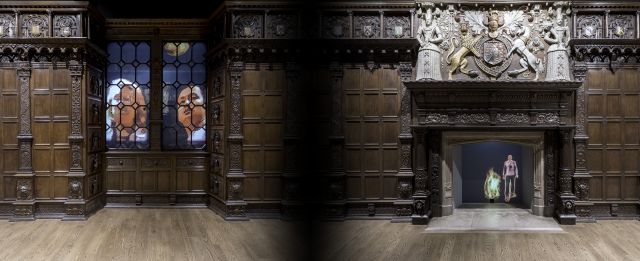Brian Knep
From Miranda Lash, curator of contemporary art at the Speed Museum:
The English Renaissance Room at the Speed Art Museum has a complex history as a "period room" that has undergone many evolutions over time. Housed in the Room's fireplace and window, Brian Knep's new media artwork Echo, presents an opportunity to investigate the meaning of a "period room" as a space that reflects the imprint of many generations. Inspired by Ovid's Metamorphoses, Knep's projections show visitors altered versions of themselves in the window and fireplace of the room, and altered versions of previous visitors who have walked through this room in the past.
The wood carvings of the English Renaissance room come from the "parlor" space at Grange, a country house located in southwest England, which was completed around 1619. It is possible that elements to the parlor were added when the house was renovated in the 1700s. The style of the room's wood carvings incorporates ancient Roman details and mythological references, as well as characters from Ovid's Metamorphoses, which was written between A.D. 7 and 8. It is likely that the English artisans who created these carvings were inspired by prints which traveled to England from the European continent, reflecting the aesthetic of Italian Renaissance art from the 1500s.
In the late 1920s, the parlor's woodwork and over-mantel were removed from Grange and offered for sale by the New York City gallery, Charles of London. They were purchased by William Randolph Hearst, the New York newspaper magnate. In 1943, Preston Pope Satterwhite, one of the Speed's important early benefactors, purchased the room as a gift to the museum. The room was significantly modified when it was first installed at the Speed, becoming several feet longer to fit into an existing space. In its current iteration, the expanded portion of the room has been removed, returning the room its original scale.
Knep's software employs cameras to capture visitors' figures and faces, with the aim of transforming them in a stylized manner. Knep describes each generation which influenced this room as a "link in the chain," each looking for insight, inspiration, and identity. In his words:
The poet Ovid is championing the magic of Greek myths as a counterpoint to Roman practicality; the craftsmen, illustrators and artists are copying and building on the styles of their predecessors; the paneling itself is a way for its various owners to show wealth and respectability; and now, in an art museum, the room questions the very way we look into the past and what it tells us about ourselves. Like the tales in Ovid’s Metamorphosis, the room becomes a way for us to understand ourselves and how we fit into our world.


